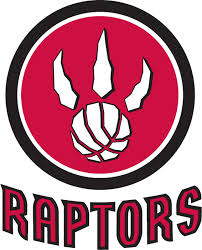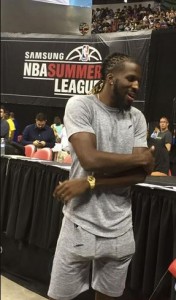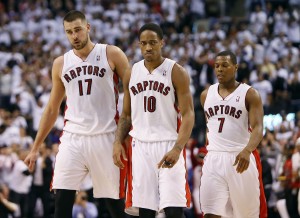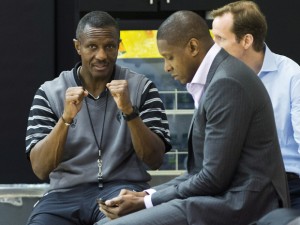 There is no way to sum up the 2014-15 season for the Toronto Raptors without including the word disappointment. You can debate the extent of it, of course – the team did win a franchise-record 49 games and saw point guard Kyle Lowry start in the All-Star Game – but the basic conclusion remains the same.
There is no way to sum up the 2014-15 season for the Toronto Raptors without including the word disappointment. You can debate the extent of it, of course – the team did win a franchise-record 49 games and saw point guard Kyle Lowry start in the All-Star Game – but the basic conclusion remains the same.
Touted as a new power in the Eastern Conference, the Raptors exploded into last season borne on a wave of “We the North” expectation. This was their time. Instead, the early season optimism gave way to a second-half collapse and disastrous first-round playoff sweep against Washington.
Unlike two years ago, there was no stirring “Almost had’em” moment for Toronto. The Raptors are now a team in flux. They are talented, but just how talented? The roster changed, but did it change the right way? The team has gone from a passionate “Why not us?” to a tentative “What now?”
As such, here are five things to consider as Toronto prepares for the 2015-16 season.
1. Meet the new guys
 After last season’s disappointing finish, GM Masai Ujiri had a clear mandate to reconfigure the Raptors. For every perceived roster deficiency, his moves this offseason proposed a solution. Got a problem with production on the wing? Hello DeMarre Carroll. Need more passing and perimeter defense in the backcourt? Welcome Cory Joseph. How about some rim protection? Come on down, Bismack Biyombo. Want some veteran savvy? Hey there, Luis Scola.
After last season’s disappointing finish, GM Masai Ujiri had a clear mandate to reconfigure the Raptors. For every perceived roster deficiency, his moves this offseason proposed a solution. Got a problem with production on the wing? Hello DeMarre Carroll. Need more passing and perimeter defense in the backcourt? Welcome Cory Joseph. How about some rim protection? Come on down, Bismack Biyombo. Want some veteran savvy? Hey there, Luis Scola.
To be clear, none of these new faces are stars in and of themselves. Carroll excelled in a superlative Hawks system tailored to his skill set, Joseph graduated from Spurs U, and Biyombo and Scola enter as specialists designed to fill holes around the returning core. Once again, the Raptors are looking to become more than the sum of their parts. And, having spent last season preaching continuity and chemistry, the team now appears set to establish a new identity. The concern, as always, remains: Will it work?
2. What’s left for the familiar faces?
There are six rotation players returning to the Raptors this season. The biggest names are All-Stars DeMar DeRozan and Kyle Lowry, who led the team to the top of the conference during the first 30 games of last season. At that point, however, DeRozan suffered the first long-term injury of his career and Lowry began to wear down. Neither player could quite get in sync again.
This disconnect extends to the returning Patrick Patterson, Terrence Ross and James Johnson. Each saw their minutes and production vary as their roles in the rotation changed from month to month. With some of their old teammates now gone, their roles will change once again. Patterson appears set to be the team’s nominal starting power forward, Ross a sparkplug off the bench and Johnson, well, who knows?
This core has already shown itself capable of competing with the league’s best teams. But competing isn’t the same as winning. After back-to-back seasons of being merely good enough, it’s fair to wonder just how far the Raptors will ever go with this group.
 3. Potential in action: Jonas Valanciunas
3. Potential in action: Jonas Valanciunas
Of all the returning Raptors, Jonas Valanciunas remains the most likely catalyst to drive significant team improvement. Last season, the Lithuanian big man averaged 12 points and 8.7 rebounds while shooting 57 percent from the field. Beyond that, advanced metrics earmark him as one of the more efficient players in the league. Yet Valanciunas ranked just 26th in minutes per game among centers who played in more than 30 games.
There were reasons for Valanciunas’ lower usage rate last season. He sat many fourth quarters in favor of a quicker Amir Johnson-Patterson front court. He played with a lot of two- and three-guard gunner-heavy lineups. And he showed mental lapses defensively that undid some of his positive contributions on the offensive end. It was clear at times that coach Dwane Casey did not quite trust Valanciunas in a big spot.
RELATED: Raptors salaries and analysis
Still, Valanciunas is only 23 years old. He just signed an extension that will pay him $64 million over the next four years. The potential, as always, appears to be there. But the time is fast arriving for Valanciunas to prove whether he can truly be a force in the modern NBA. Is this the year?
4. The last hurrah for Dwane Casey?
 Talk to Raptors fans long enough and you’re bound to hear the armchair GM assessment that Toronto should look to fire Dwane Casey. They will complain he doesn’t plan the ends of quarters well or make adjustments fast enough. Some will say he should give James Johnson more minutes, or run more plays for Valanciunas, or adjust the team’s scrambling defensive scheme. While Casey has overseen the two most successful regular seasons in Raptors history, many still consider him out of touch.
Talk to Raptors fans long enough and you’re bound to hear the armchair GM assessment that Toronto should look to fire Dwane Casey. They will complain he doesn’t plan the ends of quarters well or make adjustments fast enough. Some will say he should give James Johnson more minutes, or run more plays for Valanciunas, or adjust the team’s scrambling defensive scheme. While Casey has overseen the two most successful regular seasons in Raptors history, many still consider him out of touch.
Casey is in the midst of a three-year contract he signed after their surprising turnaround in 2013-14. Many assume Toronto was forced into retaining him after the Raptors’ sudden success; it’s hard to let a coach go after he’s guided the team through its most exciting season in over a decade. But, the final year of Casey’s contract is a team option, and it appears as though Ujiri’s roster moves were made with an unstated implication.
Last season, the Raptors were a flawed team. They could shoot themselves into or out of games and regressed on defense as the season went on. But now, on paper, the team’s offense looks more balanced, and some of its defensive deficiencies have been remedied. If Casey, a defensive-minded, move-the-ball type of coach, can’t get it done with this group of players, maybe he can’t get it done at all.
5. Holding pattern in the Eastern Conference
While Ujiri and Raptors management will never come out and say it, their guiding principle right now for roster construction is transition. Yes, the franchise did just lock Valanciunas and Carroll into fairly lucrative long-term deals, and Joseph will be with the team for a few years. But after that, the future is both wide open and uncertain.
 With the salary cap projected to rise sharply, DeRozan will most certainly opt out of the last year of his contract to seek a max deal. Lowry will presumably do the same the following year. Similarly, Johnson, Patterson, Ross, Scola and Biyombo could all be gone in a year or two. This version of the Raptors will be competitive, but it will also be temporary.
With the salary cap projected to rise sharply, DeRozan will most certainly opt out of the last year of his contract to seek a max deal. Lowry will presumably do the same the following year. Similarly, Johnson, Patterson, Ross, Scola and Biyombo could all be gone in a year or two. This version of the Raptors will be competitive, but it will also be temporary.
To be fair, this is the nature of the NBA. But in the East, with LeBron James and teams with more immediate “superstar” potential like the Milwaukee Bucks and Washington Wizards, it still feels as though the Raptors are destined to be frustrated in their championship aspirations.
Outside of the potential that Valanciunas and – further away – Bruno Caboclo, represent, the Raptors still lack that piece that gets them to the next level. And while Toronto can dream about Kevin Durant, or boast about meeting with LaMarcus Aldridge, or pine for a reunion with Canadian kid Andrew Wiggins, these kinds of leaps still feel impossible.
In the long view, this coming season may provide some idea as to not just where the Raptors are, but where they are going. Can Toronto keep pace with a rapidly changing league, or is this season really the beginning of the end?
READ EVERY SEASON PREVIEW WITH OUR TEAM INDEX
Daniel Reynolds is the editor-in-chief of Same Page Team, a Toronto-based sports and culture site, and manager of SB Nation’s Raptors HQ blog. His work can be found at The Classical and Bright Wall/Dark Room Magazine. In his spare time, he enjoys movies, books, music, basketball and writing comics and screenplays. Follow him on Twitter.